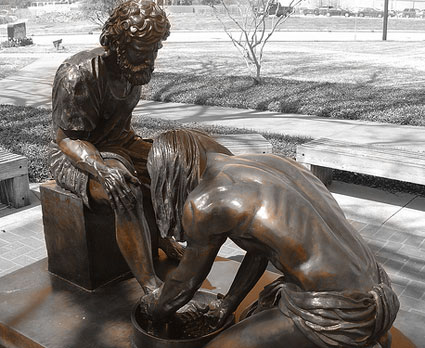Suffering Servants
or Filling Up That Which is Lacking
After reading about the Bible’s use of robes as symbols of office (see The Dominion Trap by James B. Jordan), Tim Mitchell commented:
In Bible study we’ve been looking at John, so a few weeks ago was John 13. My Bible translated v.4-5 as “So he got up from the table, took off his robe, wrapped a towel around his waist, and poured water into a basin. Then he began to wash the disciples’ feel, drying them with the towel he had around him.”
So that recalled for me the couple of pages on robe imagery, and it seems to foreshadow what Jesus will do later on very well: He is willing to take off his authority and righteousness, and take on the dirt of our sin.
But then I got a bit unsure, since Jesus then goes on to say “you ought to wash each others’ feet” in v.14 and “Do as I have done to you” in v.15. So if the symbolism applies, how are we also supposed to take other peoples’ sin on us as Jesus did?
Firstly, what a great question. Many New Testament passages become so familiar that we often lose the ability to really think about their ramifications.
The structure of the Last Supper puts this action of Jesus at Atonement, the Laver (Day 6). Jesus is liturgically pre-enacting His role as High Priest. The Adam removed his glorious robes and wore linen for the Day of Covering. Jesus left this in the tomb with our sin on it. But that is not all the High Priest did. He approached the Most Holy twice.
The High Priest entered with blood for Himself and the priests. Then he entered again with blood for the people. The suffering of those bold first century saints, including Peter, as this second entry, completed the foundation of a New Jerusalem, and brought down God’s vengeance and an end to the rebels continuing the Old Covenant rites. Christians are never taught this history, so a great deal of the New Testament is read out of context. [1]
“As living Eve sacrifices, they were to
‘fill up that which was lacking’ in
the hidden Adam Temple sacrifices”
The age of the eagle, the four empires from Babylon to Rome, is referred to as the “times of the Gentiles” (Luke 21:24). After its restoration, all Israel was supposed to be a suffering servant like Joseph or Daniel, a priesthood working to fill the empire-Tabernacle with “bread”. Although animals were again sacrificed for the nations in Jerusalem, the outward sign of this was the servanthood of the Jews scattered throughout the nations. As living Eve sacrifices, they were to “fill up that which was lacking” in the hidden Adam Temple sacrifices (Romans 12:1; Colossians 1:24). Blood is always presented in the dark, in secret, and the Lord always rewards openly.
To bring that age to an end, the disciples would “fill up that which was lacking” by passing through the same rejection and death as Jesus. His blood would be shed, but so would the blood of these disciples. In this gospel age, the Totus Christus, Jesus and church, is a corporate High Priest. [2]
The Land is always purified with blood. The kingdom is always bought with blood. I think that is what the writer of Hebrews meant when he said the first century Jews should enter the Holy Place boldly. It was certainly an expression of free access to the Throne of Grace, but such access is always mediatorial, governmental. That is the nature of both the Lord and His Creation. We are Esther standing before Ahasuerus. This is the nature of leadership according to the Bible.
The Ark and its two seraphic angels were the tomb of Jesus. The promised rest of Canaan is always entered over blood, by death, no less now that it is a heavenly country. We are to enter the Tomb boldly with our own blood for the next generation, not atoning, but demonstrating. We do this liturgically as we pass the cup to each other. [3]
We enter into death together, hidden from the world in the Holy Place, and leave church each week as resurrected saints rising out of open graves to conquer the world as living sacrifices. As broken bread and poured out wine, we feed and wash the destitute world as Jesus did, with discipleship and baptism, until all humanity is a priesthood standing with feet washed on the crystal sea.
As usual, there is also a negative side to this. The saints demonstrate the gospel of Christ by forgiving those who sin against us. But there is a final Day of Atonement coming when all the sin registered upon us will be avenged upon those who hardened their hearts as it was in AD70. [4]
_______________________________________
[1] See How to Read the New Testament.
[2] See Under Your Feet and Twelve Thrones.
[3] See Places in the Heart.
[4] See Right as Rain and No More Sacrifice for Sins.


























